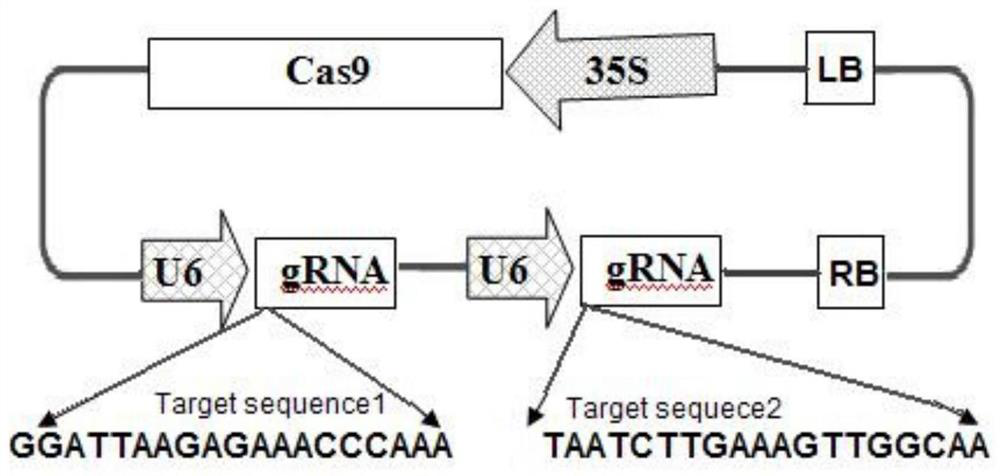Method for improving storage resistance of tomatoes through gene editing
A gene editing and genome editing technology, which is applied in the field of double-site editing of the SlACS2 gene in tomato, can solve the problems of difficult to control the ripening process of tomato, rot and deterioration, and overripe and softening of the fruit.
- Summary
- Abstract
- Description
- Claims
- Application Information
AI Technical Summary
Problems solved by technology
Method used
Image
Examples
Embodiment 1
[0041] Example 1 Design and synthesis of sgRNA for specific targeting of SlACS2 gene in tomato SlACS2 gene knockout by CRISPR / Cas9
[0042] 1. Design of sgRNA targeting tomato SlACS2 gene
[0043] Use online tools to design SlACS2-sgRNA, the specific steps are:
[0044] ① Log on to the GenBank website, search for the SlACS2 gene sequence and download it, its nucleotide sequence is shown in SEQ ID NO:4.
[0045] ② Open the target site prediction website (https: / / crispr.dbcls.jp / ), use the target site online design tool "CRISPRdirect", enter the gene sequence in the text box, select the tomato species, and you can get all the gene sequences. Finally, a set of target sites was selected for targeting after comprehensive consideration of the scoring results, GC content, specificity of the target site, and the distance between the two target sites.
[0046] ③ The 19nt oligonucleotide sgRNA core sequence was designed according to the GG(N)19NGG sequence.
[0047] The obtained sgRNA ...
Embodiment 2
[0055] The construction of embodiment 2 plant expression vectors
[0056] The CP185 and CP178 vectors were provided by the Vegetable and Flower Research Institute of the Chinese Academy of Agricultural Sciences, which are public vectors. Using the CP185 vector as a template, PCR amplification was performed with the sense strand primer (SEQ ID NO:5) and the antisense strand primer (SEQ ID NO:6) to obtain a DNA fragment containing double sgRNA and ligate it to pEasy-blunt, and the sequence was correct Afterwards, it was digested with AarI and connected to the CP178 vector to form the plant expression vector pSlACS2-DsgRNA (for the structure see figure 1 , the nucleotide sequence is SEQ ID NO: 3). The Cas9 gene on the plant expression vector is driven by 35S, and the two sgRNA genes are driven by the tomato U6 promoter. The constructed plant expression vector was transformed into Escherichia coli DH5α strain by heat shock method and amplified, and the sequence of the vector was...
Embodiment 3
[0057] Example 3 Genetic transformation of tomato and acquisition of T0 generation SlACS2 gene edited plants
[0058] 1. Obtaining sterile vaccines
[0059] Treat the prepared tomato seeds with 75% alcohol for 30 seconds, rinse them twice with sterile water, add 10% bleach, place them on a shaker for 1 hour, take out the seeds and rinse them five times with double distilled water, and place them in Refrigerate at 4°C for 12 hours, inoculate into 1 / 2 MS medium (without sucrose) and cultivate for 6 days to obtain sterile vaccines.
[0060] 2. Preparation of bacterial solution
[0061] The pSlACS2-DsgRNA glycerol bacteria contained 50mg / L rifampicin and 100mg / L kanamycin YEB solid medium (yeast extract 5g / L, peptone 5g / L, beef extract 5g / L, magnesium sulfate heptahydrate 0.5g / L, sucrose 1g / L), and cultured at 28°C for two days, pick a single clone and inoculate it into 5ml liquid YEB medium containing 50mg / L rifampicin and 100mg / L kanamycin, at 28°C , 220rpm constant temperatu...
PUM
 Login to View More
Login to View More Abstract
Description
Claims
Application Information
 Login to View More
Login to View More - R&D
- Intellectual Property
- Life Sciences
- Materials
- Tech Scout
- Unparalleled Data Quality
- Higher Quality Content
- 60% Fewer Hallucinations
Browse by: Latest US Patents, China's latest patents, Technical Efficacy Thesaurus, Application Domain, Technology Topic, Popular Technical Reports.
© 2025 PatSnap. All rights reserved.Legal|Privacy policy|Modern Slavery Act Transparency Statement|Sitemap|About US| Contact US: help@patsnap.com



